Review - Department of Innovation, Industry, Science and Research
Review - Department of Innovation, Industry, Science and Research
Review - Department of Innovation, Industry, Science and Research
You also want an ePaper? Increase the reach of your titles
YUMPU automatically turns print PDFs into web optimized ePapers that Google loves.
improvements may be seen in <strong>and</strong> around the college, <strong>and</strong> these are motivated<br />
explicitly by the key quality criteria.<br />
• Organised effort—means that quality process initiatives begin to be planned <strong>and</strong><br />
tracked, work methods are systematically rooted in the quality criteria, <strong>and</strong> the<br />
college has begun to develop performance metrics <strong>and</strong> norms.<br />
• Mature effort—means quality processes have been embedded in the college’s<br />
culture, continuous improvement is a way <strong>of</strong> life, <strong>and</strong> organisational learning<br />
about <strong>and</strong> commitment to QA&I are fully established.<br />
Similar to AUQA audits, there are recommendations, affirmations <strong>and</strong><br />
commendations. The draft report is forwarded to the college <strong>and</strong> it has 30 days to<br />
respond. A final draft is then prepared. The executive summary is posted on the<br />
OCQAS website, <strong>and</strong> follow-up reports (as to progress against the<br />
recommendations) are also posted with it.<br />
The follow-up reports are self-reports <strong>and</strong> meant to serve as an interim status report<br />
on how the college is doing with the implementation <strong>of</strong> its plans. It will serve the<br />
next round <strong>of</strong> audits as a starting point (along with the initial audit report). In cases<br />
where the board may believe there is not a demonstrated movement towards<br />
implementation <strong>of</strong> the plans or recommendations, it has the right to send in another<br />
panel (that is, to have the college undergo another audit before the full five-year<br />
cycle. This has not been the case to date).<br />
An appeals process is also in place, <strong>and</strong> the appeal can be raised within 30 days <strong>of</strong><br />
receiving the draft final report.<br />
Provided in the Program quality assurance process audit: orientation manual, at<br />
www.ocqas.org/pqapa-orientation-en.pdf are:<br />
• site visit agenda<br />
• final report template<br />
• sample audit checklist/form.<br />
Transnational<br />
application<br />
Comment<br />
The institution is expected to have policies, practices, <strong>and</strong> procedures in place that<br />
cover all programs <strong>of</strong>fered by the institution. In addition, one <strong>of</strong> the quality criteria<br />
(criteria 3) specifically addresses ‘<strong>of</strong>f site’ delivery <strong>of</strong> programs.<br />
Other monitoring strategies include:<br />
key performance indicators<br />
CAATs are required to annually submit data on five indicators:<br />
• graduate employment<br />
• graduate satisfaction<br />
• employer satisfaction<br />
• student satisfaction<br />
• graduation rate.<br />
Multi-year accountability agreements (MYAAs)<br />
Each CAAT has a MYAA with the Ministry <strong>of</strong> Training, Colleges <strong>and</strong> Universities<br />
<strong>and</strong> submits an annual report on its performance that monitors the use <strong>of</strong><br />
government funds against government goals <strong>of</strong> access, quality <strong>and</strong> accountability.<br />
Comparisons <strong>of</strong> international quality assurance systems in vocational education <strong>and</strong> training Page 74 <strong>of</strong> 115
















